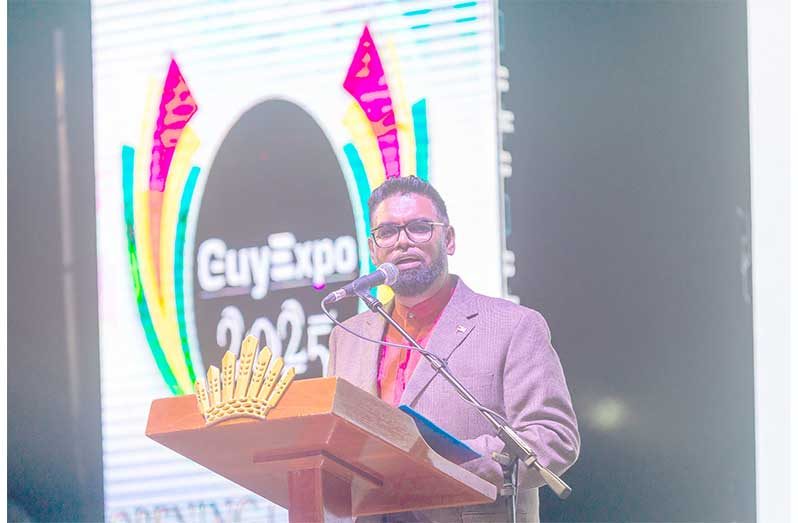–Touts soaring non-oil growth and record investor confidence as data shows economy ‘strong, robust, full of energy’
PRESIDENT Dr. Irfaan Ali has affirmed that Guyana is entering its “golden age,” shedding the economic stagnation seen between 2015-2020 and replacing it with exponential manufacturing growth, rising investor confidence and an economy he describes as “strong, robust, and full of energy.”
The President made those remarks during the opening ceremony of GuyExpo 2025 last Thursday, where he explained how “leadership and vision” have directly shaped Guyana’s economic performance over the decades and how his administration reversed previous economic setbacks under the coalition government.
According to the Ministry of Finance’s mid-year report, Guyana’s economic growth expanded by 7.5 per cent for the first half of 2025, and the growth of the non-oil economy grew by 13.8 per cent. This marks five years of consecutive years of expansion.
Global institutions have also recorded and commended Guyana’s rapid development. Earlier this year, the International Monetary Fund (IMF) highlighted Guyana’s macroeconomic stability and praised the government’s commitment to fiscal discipline and inclusive growth.
In its Staff Concluding Statement for the 2025 Article IV Mission, it pointed out Guyana’s impressive economic growth, driven by a combination of rapidly expanding oil production, robust non-oil output, and substantial public infrastructure investment.
FROM DECLINE TO EXPANSION
Using long-term data to illustrate the impact of policies while providing context into Guyana’s manufacturing journey, President Ali recalled that in 1991 the total manufacturing output was estimated at USD13.1 million, but noted that it fell by 81.6 per cent when compared to 1981, which was US$71.7 million.
In spite of this deep slump, he noted that with sustained policy direction under the People’s Progressive Party/Civic (PPP/C), the government grew that manufacturing output to USD161.58 million.
The PPP/C continued to push the sector upward, and from 2006 to 2014, the PPP/C grew the manufacturing output from US$161.58 million to US$249.57 million.
While stating that “leadership is important,” the President emphasised that the significant growth that took place within those periods, under the PPP/C, was pre-oil.
Fast forward to 2018, with oil emerging, President Ali noted that under the previous coalition administration, manufacturing input had fallen to US$223.51 million, marking a reversal from earlier gains.
“Leadership matters, governments matters, vision matters, confidence matters, and hard work is essential,” President Ali said.
Additionally, the President further pointed to several other indicators showing weakening performance of many industries under the then A Partnership For National Unity +Alliance For Change (APNU+AFC) administration.
Between 2015 and 2020, the average decline in food manufacturing was 1.96 per cent, and the decline was sharper for other sub-sectors, like clothing, footwear, leather and wood products.
EXPONENTIAL GROWTH
Since returning to office in 2020, the PPP/C administration has overseen a strong economic recovery.
“Guyana’s manufacturing sector has experienced exponential growth at an average of 13.1 per cent annually. Leadership matters. Hard work matters. The government we elect matters, so too does the opposition you look at,” President Ali boasted.
According to the Ministry of Finance’s mid-year report, the 26.8 per cent growth of the manufacturing sector in the first half of 2025 was driven by growth across all subcategories.
Additionally, it should be noted that Guyana’s momentum is being reinforced by an ambitious range of infrastructural and economic projects, which are aimed at accelerating national development, job creation, and regional integration.
The major projects include: construction of a brand-new Berbice River Bridge, development of a bridge across the Corentyne River in collaboration with Suriname, establishment of a second gas-to-energy plant in Region Six, creation of an economic zone in Berbice, construction of a deep-water harbour, expansion of the Demerara Harbour, development of a national digital backbone under the Digital Guyana Project, and planning for fertiliser and natural gas plants to position Guyana as an industrial powerhouse in the region.
Central to this transformation is Guyana’s landmark gas-to-energy project, which is poised to fuel far more than affordable electricity but also serve as the foundation for the development of the expansive Wales Development Zone.
The 1,400-acre Wales Development Zone is the centrepiece of Guyana’s emerging industrial landscape and is set to host a range of new industries, including a fertiliser plant, data centres, and manufacturing facilities.
President Ali recently emphasised that the gas-to-energy project is not just about a pipeline and power generation, but about building the foundation for a diversified, production-driven economy. He noted that the integration of industrial facilities within the development zone will help create thousands of jobs, reduce operational costs, and boost competitiveness across multiple sectors.
The head of state recently disclosed that Guyana could soon become home to a major glass manufacturing industry, capitalising on the country’s high-quality sand to produce glass products for international markets, including the automobile sector. He said the initiative forms part of the government’s industrial diversification strategy, which aims to leverage the nation’s natural resources beyond oil and gas.
RISING CONFIDENCE & INTERNATIONAL RECOGNITION
Dr. Ali stated that Guyana is “open for business,” and he referred to the more resilient investment climate that has been created for investors.
“You look at between 2021 and 2024 foreign direct investment, which totalled US$209.97 million, three times that of 2015 and 2020, three times the growth,” he said.
The Foreign Direct Investment (FDI), in just two years (2021 to 2023), was also more than three times the FDI that the former APNU+AFC government was ever able to attract during its five-year tenure in office.
The surge in investor confidence has also gathered global attention, as last month, global banking giant, Citibank, described Guyana as “a compelling opportunity.” The renowned financial powerhouse announced plans to establish a representative office in Georgetown.
The move underscored Citi’s growing confidence in Guyana’s explosive economic trajectory, fuelled by record-breaking growth in the oil and gas sector, infrastructure expansion, and increased export financing.
The PPP/C government’s efforts to strengthen public-private partnerships, modernise infrastructure, and diversify the economy have been pivotal in catalysing the nation’s investment boom.
However, the government has also been keen to ensure that the benefits of this influx of capital are felt across the economy, and notably, the expansion of the private sector, driven by foreign investments, is generating thousands of jobs and contributing to an overall improvement in the standard of living for Guyanese citizens.
NEW OPPORTUNITIES FOR GROWTH
At the opening ceremony of GuyExpo, President Ali also announced that the forthcoming Guyana Development Bank will be capitalised with a minimum of US$200 million and is expected to become operational before the end of the first quarter of 2026.
The administrative, legal, and regulatory framework for the institution is already being crafted. It will operate in close integration with commercial banks, with the goal of unlocking greater access to capital.
According to the President, a special incentive regime will be introduced to encourage commercial banks to expand lending to small and medium-sized enterprises (SMEs), mirroring the incentives offered to banks in the housing sector.
In return, commercial banks will be required to lower interest rates to below four per cent and reduce collateral requirements for SME borrowers. The Guyana Development Bank will also offer loans with no collateral requirement and a zero per cent interest rate up to a predetermined threshold, which will be unveiled in the 2026 National Budget.
A CONTRAST WITH 2015-2020
Guyana is on the cusp of a significant transformation that could reshape the nation into a regional leader, but this was not always the nation’s position, as President Ali highlighted.
According to a previous statement issued by the IMF, credit to the private sector only grew 2.1 per cent in 2017 due to a combination of weak demand and banks continuing to strengthen their balance sheets.
This documentation, along with other reports, showed low private-sector growth and weak investor confidence during the APNU+AFC term- an indicator that the private sector did not expand strongly between 2015-2020.
Additionally, tax hikes, budget cuts and bureaucratic obstacles have also been labelled as reasons private investment was low under the previous coalition administration.
The previous APNU+AFC administration has faced much criticism for its performance in office, especially for the stagnation of the local economy. In fact, the private sector frequently accused the APNU+AFC of creating significant barriers to investment, noting that the policy environment they created was not feasible.
The APNU+AFC implemented over 300 taxes and fees, including: 14 per cent Value Added Tax (VAT) on electricity and water, mobile internet, and private health and education services, which sparked widespread disgruntlement from business owners and consumers alike. The fees for small operators and businesses, including cart operators, were also raised significantly.
Credit to Guyana’s private sector has been growing significantly, under the PPP/C administration, and this expansion is a result of government policies fostering investment and a robust financial environment.
UPWARDS TRAJECTORY
Given the findings that confirm Guyana’s economy is robust and energetic, the President cautioned citizens against what he termed the “bubble of social media” and politically driven misinformation.
“When you come to the facts and you examine the truth, you will have a full and thorough understanding as to the development and the pace of transformation of our country,” the President told the large gathering.
While dismissing detractors, President Ali told citizens that the actual economic data shows a country undergoing rapid transformation, underpinned by both private and public sector leadership.
“Our economy has just undergone its half-year checkup. And what was the outcome of the half-year checkup of our economy? The checkup shows our economy is strong, robust and full of energy,” President Ali said.



.jpg)








